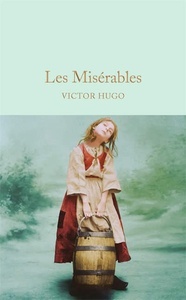Les Miserables

Editorial Pan
Colección Macmillan's Collector's Library, Número 0
Fecha de edición septiembre 2016 · Edición nº 1
Idioma inglés
EAN 9781909621497
472 páginas
Libro
encuadernado en tapa dura
Dimensiones 97 mm x 150 mm
Resumen del libro
Les Miserables is a magnificent, sweeping story of revolution, love and the will to survive set amidst the poverty stricken streets of nineteeth-century Paris. Escaped convict Jean Valjean turns his back on his criminal past to build his fortunes as an honest man. He takes in abandoned orphan Cosette and raises her as his own daughter.
But Jean Valjean is unable to free himself from his previous life and is pursued to the end by ruthless policeman Javert. As Cosette grows up, young idealist Marius catches a glimpse of her and falls desperately in love. The fates of all the characters await them during the violent turmoil of the June Rebellion in 1832.
This abridged version of Victor Hugo's masterpiece was published in 1915 with the aim to provide 'a unified story of the life and soul-struggles of Jean Valjean'. Published as a gift edition with a new introduction by Paul Bailey. Designed to appeal to the book lover, the Macmillan Collector's Library is a series of beautiful gift editions of much loved classic titles.
Macmillan Collector's Library are books to love and treasure.
Biografía del autor
x{0026}lt;P x{0026}lt;B Victor Hugox{0026}lt;/B (1802-1885) nació en Besançon, Francia. Educado en escuelas privadas de París, empezó a escribir siendo muy joven. Poeta, novelista y dramaturgo, llevó a sus obras su espíritu inconformista, que sazonó con grandes dosis de sentimentalismo y anécdotas históricas. En sus obras, exponentes máximos del romanticismo literario, siempre volcó su ideologíaliberal, que le obligó a exiliarse de su país en más de una ocasión. Tras el volumen de poesía x{0026}lt;I Odas y poesías diversasx{0026}lt;/I (1822), las novelas x{0026}lt;I Han de Islandiax{0026}lt;/I (1823) y x{0026}lt;I Bug-Jargalx{0026}lt;/I (1824), y los poemas de x{0026}lt;I Odas y baladasx{0026}lt;/I (1826), escribió x{0026}lt;I Cromwellx{0026}lt;/I (1827), extenso drama histórico, y x{0026}lt;I Marion de Lormex{0026}lt;/I (1829), obra teatral censuradapor ser demasiado liberal. Pero no fue hasta 1830, con la publicación y el estreno de x{0026}lt;I Hernanix{0026}lt;/I , posteriormente adaptada por Verdi, cuando logró el reconocimiento del público y de la crítica. A x{0026}lt;I Hernani x{0026}lt;/I siguieron la novela x{0026}lt;I Notre-Dame de Parísx{0026}lt;/I (1831), la obra teatral x{0026}lt;I El rey sediviertex{0026}lt;/I (1832, adaptada por Verdi en x{0026}lt;I Rigolettox{0026}lt;/I ), x{0026}lt;I Lucrecia Borgiax{0026}lt;/I (1833), x{0026}lt;I Claude Gueuxx{0026}lt;/I (1834), x{0026}lt;I Ruy Blasx{0026}lt;/I (1838) y x{0026}lt;I Les Burgravesx{0026}lt;/I (1843), también obra teatral, que le supusieron su ingreso en la Academia Francesa en 1841. Durante el Segundo Imperio emigró a Bélgica, donde escribió la sátira x{0026}lt;I Napoleón el pequeñox{0026}lt;/I (1852), el poema épico x{0026}lt;I La leyenda de los siglosx{0026}lt;/I (1859-1883) y terminó la que sería su obra más extensa y famosa, x{0026}lt;I Los miserablesx{0026}lt;/I (1862). Regresó a Francia en 1870, donde siguió publicando: x{0026}lt;I El noventa y tresx{0026}lt;/I (1874) y x{0026}lt;I El arte de ser abuelox{0026}lt;/I (1877). Murió en París, y sus restos fueron expuestos en el Arco de Triunfo y luego trasladados al Panteón, donde fue sepultado junto a las mayores celebridades francesas.x{0026}lt;/P








